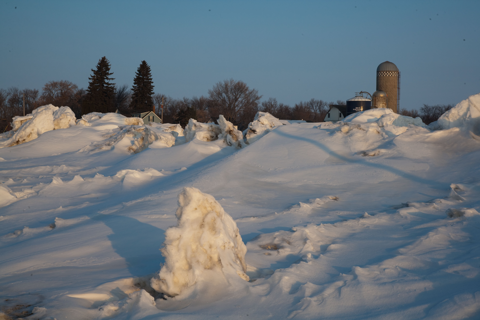Quick facts
- Water from melted snow and spring rains can flood buildings in low areas.
- Thawing and refreezing snow can create hazardous icy areas for people and livestock.
- During winter, farmers can take steps to help prevent springtime snowmelt problems on their farmsteads. There are also steps that can be taken before winter begins to help prevent springtime snowmelt problems.
After a winter of heavy snow and ice, farmers should consider where the snowmelt will go and how it could make farm operations difficult in the spring.
Early snowmelt and spring rains can run across frozen ground, gather in low spots and create flooded areas. Melting snow can flood buildings, feed and bedding storage areas in low areas, which can damage feeds, bedding or equipment.
It can be hard on both animals and equipment to go through flooded roads or lanes. Refreezing can convert flooded lanes into slippery ice-covered areas that can give way as equipment or animals go over them.
Animal exercise lots or outdoor feeding areas can also become messy with snowmelt running across or gathering. Feedlot runoff needs to be managed properly to prevent contaminating surface waters. It is also important to prevent snowmelt from entering in-ground manure storage pits or basins.
After snowfall actions
Here are three actions to take after snow has fallen and before spring snowmelt begins.
Remove deep snow
Plow or scrape snow off to the side of outdoor exercise lots, feeding areas and heavy traffic lanes. Avoid pushing uphill of outdoor lots, feeding areas and traffic lanes. This will reduce snowmelt that is in — or drains through — the lot or feeding area. Avoid removing manure or wasted feed with the snow unless it will be land applied properly to cropland.
Pile snow strategically
Carefully consider where you place snow when you move it around the farm. Locate piles so snowmelt will drain away from animal lots or traffic lanes rather than through them.
Check covers on manure storage pits and basins
Ensure pump-out covers on deep manure pits are properly seated so snow and roof runoff do not drain into the pit. Adding snowmelt and rain runoff to a manure storage facility reduces manure storage capacity and adds to land application costs.
Before winter actions
Here are actions to take before winter to help avoid future snowmelt problems.
Divert drainage
In the spring, take a good look at the overall farmstead drainage pattern. If other parts of your property drain through the animal yards, feed storage areas, or high traffic areas, regrade the slope or add shallow diversion ditches so runoff water flows around the areas you want to protect.
Manage roof runoff
On some farms, water runs off the barn roof into animal lots. A shallow trench or ditch beneath the overhang can help direct this water out of the yard. Better yet, install gutters and downspouts that empty away from the animal lot. Also, grade the ground around farm buildings to slope away from the building. This helps move snowmelt and rain runoff away from the building and its contents.
Add a pad or use geotextile fabrics
Concrete or all-weather geotextile pads along feed bunks and around waterers can help eating and drinking animals stay high and dry. Make pads 10 to 12 feet wide for best results. Geotextile fabrics can also be added to traffic lanes to improve stability. Pads at the entrances to outdoor feed storage areas and machine sheds can be helpful, too.
For more information on geotextile pads and lanes, see using all-weather geotextile lanes and pads from Iowa State University.
Raise your grade
Another long-term solution is to avoid placing buildings, feed and bedding storage in low areas. And grade animal yards and the farmstead to provide continuous drainage away from the animals, feed storage, and high traffic areas. A 4 to 6 percent slope is recommended.
Reviewed in 2016


